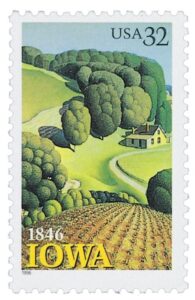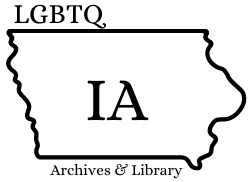 This month, we delve into the history of the Iowa City Women’s Press.
This month, we delve into the history of the Iowa City Women’s Press.
Although the press was founded in 1972, we have to start a few years earlier with the publication of arguably its most famed publication, the newspaper Ain’t I A Woman? (AIAW?). In 1969 amidst the eruption of Gay Liberation and Women’s Liberation movement organizations across the U.S., the Iowa City Women’s Liberation Front was founded. Heavily influenced by the local activism of Iowa City, the Women’s Liberation Front was founded amidst Vietnam protests, Gay Liberation organizing, and the development of Action Studies on the University of Iowa’s campus. The Action Studies program offered courses in women’s studies, African American studies, and human rights.1
Due to the large number of women interested in being involved with the Women’s Liberation Front upon its founding, they split into small collectives or “cells” as they referenced them, to accomplish more with ease. The original cells included a paper (AIAW?), a political study group, a medical cell (eventually the Emma Goldman Clinic that operates in Iowa City to this day), a revolutionary art cell, a daycare center, and a lesbian cell.2
The publication collective of Iowa City’s Women’s Liberation Front published the first issue of AIAW? on June 26, 1970. This issue sold for 25¢ and features the iconic illustration of Sojourner Truth, bespectacled with an oversized left arm raised in a fist. Truth’s famed 1851 speech is quoted at length on the cover. The image and quote speak to two distinct historical moments: one regarding black womanhood and the dual weight of enslavement, the other harkening to the contemporary Black Power movement. The tagline of the newspaper is simply,” A Midwest Newspaper of Women’s Liberation,” making a firm commitment to regionality and place.3
The Collective actually acknowledged that the first issue was too Iowa City-centric, hoping to encourage submissions from across the Midwest. The newspaper served as a vehicle for raising consciousness and building community across the Midwest. They guaranteed feminist organizations throughout the region printing of full page layouts without editing content – to give space, voice, and autonomy.4
In slight conflict with the desire to include many regional voices, was the collective’s preference to run the newspaper though a tight knit circle of women who shared beliefs and authority. They actually restricted new members and temporary volunteering opportunities. Inclusion was difficult precisely because many of the members lived together and would work on the publication from home.5 Returning for a moment to the cover of the first AIAW? cover, the exclusive white women’s publishing collective utilizing radical racialized symbolism on their cover only highlights the whiteness of the collective. This calls into question their commitments to solidarity and inclusion of women of color and other social movements historically adjacent to women’s liberation.
After a year and a half of publishing AIAW? the collective ran into a printing snag. The November 1971 issue of AIAW? includes the following note on the back cover:
This was to be a twelve page paper with four pages of medical self-help material on menstural extraction. However we couldn’t get them printed.6
The inability to find a printer that would print medical information about women was the spark, the catalyst for the founding of the Iowa City Women’s Press in 1972. Between the AIAW? cell and the broader women’s liberation organization there was enough demand for a fully autonomous women’s press. This was the key to the press’s success over its 13 year lifespan.
In the 1980s, the Iowa City Women’s Press was the only press in the U.S. where publications could be typeset, printed, and bound in a woman owned and operated setting. The press outgrew the Midwestern boundaries set by AIAW? (which stopped publishing by 1974). The press became a popular business to be utilized by lesbian and feminist publications from across the country.7
The Iowa City Women’s Press was founded with two key principles: to help women gain control over the printed word AND to equip women with the skills to combat income inequality. This guiding moral compass for the press is what led to the publication of both The Greasy Thumb Automechanics Manual for Women (1976) and Against the Grain: A Carpentry Manual for Women (1977).8
The literary history of Iowa City is also entwined with that of the Women’s Press. In the springs of both 1971 & 1972 they organized feminist poetry readings and eventually decided to publish the work. All Women Are Welcome to Read their Poetry (1972) was the first book published by the press. They printed 2,000 copies on a mimeograph machine. The proceeds from the book funded the purchasing of offset press equipment. Within the pages of the anthology, the politics of the press were written, describing the reclamation of the mimeograph machine as a woman’s tool laboring under men, to a vehicle for, “respecting people’s labor within the limitation of the only machine allowed to us.”9
The Iowa City Women’s Press was touted as a lesbian press collective in the pages of DYKE: A Quarterly. Lesbian run, the press prioritized growing the skill sets of all women both through working at the press and their publications.10 Started in a converted garage and disbanded in 1985, the Iowa City Women’s Press was an emblem of the intersection between women and lesbian liberation. It disbanded for two reasons: the era of social movement radicalism was ending amidst a conservative backlash and the change in printing technology made it unviable economically. No longer in existence, their history we remember and preserve.
In Solidarity and Love
Notes
- “Power to the Printers: The Alternative Press in Iowa City, 1965-1985,” The University of Iowa Libraries, (2017). Exhibition Catalog.
- “More Thoughts on Structuring a Revolution,” Ain’t I a Woman?, 1, no. 1 (June 26, 1970): 2.
- Ain’t I A Woman? 1, no. 1 (Iowa City, IA), June 26, 1970.
- Agatha Beins and Julie R. Enszer, “‘We Couldn’t Get Them Printed,’ So We learned to Print: Ain’t I A Woman? and the Iowa City Women’s Press,” Frontiers 34, no. 2 (2013), 192. Outside of Biens’ multiple writings on the press, there is a dearth of information on the history of the press and its publications. They do not even have Wikipedia pages, something we hope to change. This history-by-letter is a first step.
- Ibid., 195.
- Ain’t I A Woman? (Iowa City, IA), November 19, 1971.
- Agatha Beins and Julie R. Enszer, “So We Learned to Print,” 202. These publications of quintessential lesbian journals printed out of the Iowa City Women’s Press included Sinister Wisdom (CA), Lesbian Connection (MI), Common Lives/Lesbian Lives (IA), and MAIZE (NM).
- Both of these tiles have been acquired by the LGBTQ Iowa Archives & Library. We are still searching for other publications to add to our collection printed by the Iowa City Women’s Press. What a joy to preserve this history, locally.
- All Women Are Welcomed to Read their Poetry. Iowa City Women’s Press, 1972.
- “Correspondents: Iowa City,” DYKE: A Quarterly, no. 2 (1976).
